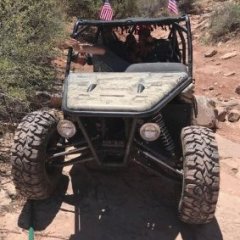Bob's Can Am Maveric XRC.
-
Similar Topics
-
By Gary T
I generally use my challenger for light duty misc. use, and for plowing. The one thing I dislike about this machine is the difficulty in shifting. I've had it the shop and they adjusted the shifting lever, but I still have issues. Some times it shifts ok, but the problem is it is hard to get it to move the lever from high to reverse or low to high or from any gear to the other. Seems I always have to accelerate a little to get it to engage to what gear I need it to go to. This is definitely not normal.
-
By Kingfish
The conversion took about 350lbs. off the vehicle. It never rode great, but now I feel every crack in the road. I have backed off spring compression nut to the point just under where they would move around if suspension was at full extension, but it is still very stiff. I would like to put some softer coilover springs on it, but I have no idea what the spring rate is with the original springs so I would just be guessing on what to order. Does anyone have the data for the original spring compression rate? I am willing to give up a little ground clearance for a softer ride. Right now when sitting still the rear suspension is at or near full extension and the rear tires have several degrees of camber which will cause uneven wear if allowed to continue in this state.
-
By 2scoops
I am in need of an IAC for my throttle body. I contacted JMC and they said I had to buy the whole throttle body for $209. I left a message at Joyner USA...they haven't called back. I found a Chinese company which have them for $17, but shipping is $32. With that I still have to hope it is the correct one which arrives.
Does anyone happen to have one laying around they would sell?
I understand a workaround would be to eliminate it and use the idle screw. I believe that would cause problems with cold start ups??? Elevation changes???
-
By Jim Kessell
2005 American Landmaster
EH65 Subaru Robins
spits fuel from breather hose into the air cleaner and then down into carb. What’s causing this ??
-
By hetovi
Hey everyone,
I’m in the market for a UTV windshield that can withstand extreme conditions, including high winds, dust, and off-road impacts.
I’ve seen a lot of options out there, but I’m unsure which one will provide the best protection and durability.
Does anyone have experience with windshields that excel in these environments? Are there specific brands or materials you recommend?
I’m particularly interested in options that offer both durability and clarity.
Any tips or personal experiences would be greatly appreciated!
-








Recommended Posts
Join the conversation
You can post now and register later. If you have an account, sign in now to post with your account.